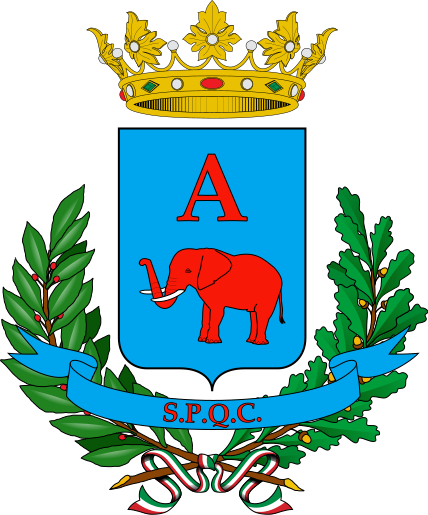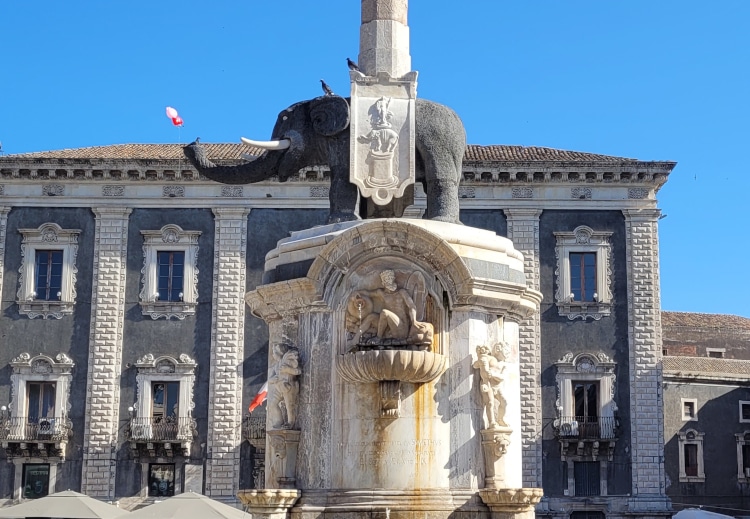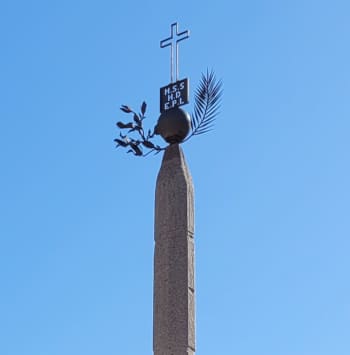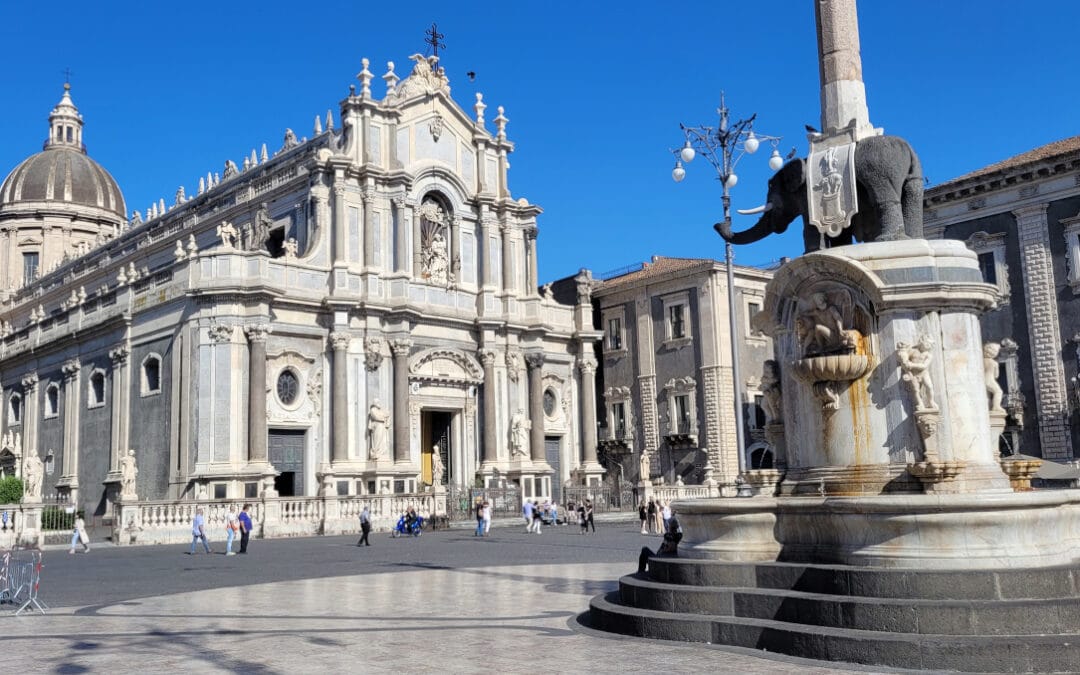At first glance, Sicily and Catania have nothing to do with elephants. Yet a red elephant is emblazoned on Catania’s coat of arms and in the heart of the city in Cathedral Square (in front of Sant’Agata Cathedral), a black elephant with an obelisk on its back stands in the middle of a fountain – Catania’s emblem.
What is this all about?

The coat of arms of Catania consists of different elements:
- The crown recalls the rule of the kings of Aragon over Sicily.
- S.P.Q.C. stands for Senatus Populusque Catanensium (the Senate and People of Catania).
- A stands for Saint Agatha, the patron saint of the city, to whom the cathedral is also dedicated.
The coat of arms of Catania
The coat of arms as you see it above probably dates from 1239. In that year Frederick II subordinated the city to the king; before that it was under the rule of the bishop and had the episcopal coat of arms with St. George. From then on, the city could govern itself autonomously and therefore wanted to choose its own coat of arms to represent its independence.
The elephant was naturally chosen, as it had long been a symbol of the city. In fact, Catania is already referred to as the “city of the elephant” in a report by an Arab geographer from the 2nd half of the 10th century. At that time, the inhabitants of Catania are said to have seen the elephant as a symbol of protection from the eruptions of Mount Etna.
There are many explanations as to why an elephant is the symbol of Catania, some of which clearly belong to the realm of myth. But even historians disagree about the true origin.
Let us therefore start with what we know for sure.
The Elephant Fountain of Catania
The black elephant is made of lava from Mount Etna and dates back to Roman times. However, the exact age is unclear. It was carved from a single block of lava and placed in different places in Catania over the centuries.

Two earthquakes on 9 and 11 January 1693 destroyed large parts of Catania, one of the worst earthquakes in the history of the eastern side of Sicily. The statue of the elephant was found in the ruins of the city, its hind legs and trunk mutilated.
During the reconstruction of the city, Giovanni Battista Vaccarini, an architect from Palermo, built a fountain between 1735 and 1737, in the centre of which he placed the elephant. He restored the elephant’s destroyed limbs and gave it eyes and tusks made of white limestone.
The fountain itself is made of white marble and is adorned by two statues representing the two rivers of Catania: the Simeto and the Amenano.
We do not know much about the Egyptian obelisk that Vaccarini placed on the white marble saddle of the elephant: it is made of granite, 3.66 m high and is covered with numerous images of animals and people. It was probably brought to Catania from Egypt at the time of the Crusades. Its shape is interesting: usually obelisks have a square cross-section, but this one is eight-sided.
On the top of the obelisk, in honour of Saint Agatha, there is a globe and a cross, adorned with a lily (symbolising her purity) and a palm frond (symbolising her martyrdom). On a small plaque we read the letters M. S. S. H. D. E. P. L. These stand for Mentem sanctam, spontaneam, honorem Deo et patriae liberationem (She had a holy voluntary disposition, she gave glory to God and liberation to her homeland).

How did Catania get its landmark?
Now we finally have to clarify how Catania comes to have an elephant. The following theory is often mentioned:
Sicily has had a very varied history. The island was repeatedly settled or warred over by different peoples. Sicily was also of interest to the Punic (Phoenicians), who settled North Africa with their capital Carthage (near today’s Tunis in Tunisia).
From the 9th century BC, the Carthaginians had trading posts in the west of Sicily, and later they wanted to expand their dominion and take more of the island. This led to problems with the Sicans and Greeks who lived there.
In 278 BC, Sicily called on King Pyrrhos I (a Greek king) for help against the Carthaginians. Pyrrhos was at that time at war against the young Roman Republic, he wanted to conquer Lower Italy. He arrived in Italy not only with many soldiers, but also with 26 elephants trained for war. With these elephants he also fought in Sicily, was able to defeat the Carthaginians and conquered a large part of Sicily. He then made himself king of Sicily.
These elephants must have been a truly unusual and frightening sight for the people of Sicily at the time. Since they helped in the liberation of Carthage, they became the guardian animal of Catania.
But there is also a completely different explanation for the unusual heraldic animal: the elephant was dedicated to the Greek god Dionysus (Roman: Bacchus), the god of wine, fertility and joy, but also the god of madness or ecstasy. Dionysus is said to have travelled on elephants as far as India; his chariot was pulled by elephants, among others. The cult of Bacchus also came to Sicily through Greek settlement. Since it enjoyed great popularity, the elephant may have become the heraldic animal of Catania.
The following explanation comes from the realm of legends:
The Wizard Who Flew on the Elephant
The inhabitants of Catania call their elephant u Liotru in the Sicilian dialect. This name is said to go back to the name of a magician who called himself Eliodoro. In the course of time, this is said to have become u Liotru.
Eliodoro lived in Catania in the 8th century AD. At that time, the city was under Byzantine rule, i.e. part of the Eastern Roman Empire. He came from a noble family and dedicated his life to the Catholic church. When he tried – in vain – to become bishop of Catania, he was so enraged by this that from then on he devoted himself to magic. At least that was the accusation of his contemporaries.
Here we leave the historical events and come to the legend.
One night, Eliodoro summoned the devil and made a pact with him. Eliodoro denied his faith in Christ and received supernatural abilities in return.
With his magical powers, he created an elephant from the lava of Etna and breathed life into it. He flew around the city on it, joking with the people of Catania. He also travelled back and forth on the elephant between Byzantium (Constantinople) and Catania.
Once Eliodoro is said to have shopped at the market and paid for everything with gold and diamonds. But as soon as he left, the precious items turned into stones. Another time he persuaded the bishop’s nephew to bet on a horse race. He won. But at the award ceremony, the winning horse confessed that it was really the devil himself and only wanted to make fun of the nephew.
For this, Eliodoro was thrown into prison. But he was able to escape because he bribed the guards with gold, which – correctly guessed – turned back to stone shortly afterwards. He was then sentenced to death by Constantine, the ruler of Byzantium. As his last wish shortly before his execution, he asked for a bowl of water. He dipped his head into it and disappeared. One could still hear the words: “Whoever wants me, let him look for me in Catania!”
And yet another time he was led before the executioner because he had set fire to the backside of a minister’s wife. But this time too he escaped because he suddenly became tiny, crawled into the executioner’s sleeve and came out of the other sleeve. “I escaped the first time; this is the second time. If you want me, look for me in Catania!” he shouted and disappeared again.
Only Bishop Leone II of Catania is said to have managed to free the city from the sorcerer’s evil pranks by reading a mass of atonement. Eliodoro was reduced to ashes.
Here, historical reality catches up with us again: Eliodoro, an adversary of Bishop Leone throughout his life, was condemned to death by the latter for his black magic practices and burned alive in 778.
But the elephant of Eliodoro remained and is still closely associated with Catania. It is not only found in the coat of arms of the city of Catania, but also in the coat of arms of the University of Catania and is the mascot of many sports teams.
